
From 'Action!' to Action Figure or There and Plastic Again
 Gentle Giant Studios in Burbank California has been transforming actors into action figures for several years, and their latest subjects have been the denizens of Middle Earth. Gentle Giant packed their bags and headed west to New Zealand to work on the big-budget LOTR trilogy to help Toy Biz capture the likenesses of the major characters from the films. Gentle Giant also created some prototypes where no actor existed - for computer-generated characters such as the cave troll or Balrog. Gentle Giant Studios in Burbank California has been transforming actors into action figures for several years, and their latest subjects have been the denizens of Middle Earth. Gentle Giant packed their bags and headed west to New Zealand to work on the big-budget LOTR trilogy to help Toy Biz capture the likenesses of the major characters from the films. Gentle Giant also created some prototypes where no actor existed - for computer-generated characters such as the cave troll or Balrog.
So how did they do it, short of shrinking the actors down and casting them directly in plastic, or having Gandalf cast a spell. The answer is simple - technology. Technology developed not by Elves or Hobbits, but by wizards. Wizards who use light and shadow rather than the traditional smoke and mirrors.
We are going to look at the process that takes an award-winning Shakespearean actor (Sir Ian McKellan) and translates him into a six-inch plastic doppelganger. And it didn't hurt a bit! For computer-generated (CG) characters the process is nearly the same, except that the CG characters don't need to be scanned as they already exists as digital image data used to create the images for the film.
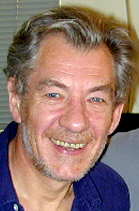 Like a great meal, the plastic version of the wizard Gandalf requires the finest ingredients before starting on the recipe. Luckily, that is met in Sir Ian McKellan. Sir Ian is an award-winning actor (not to mention an Academy Award Nominee) with a strong Shakespearean background who's no stranger to diverse projects, or to action figures. Toy collectors may best know Sir Ian for his work in X-Men, where he played Magneto. His work in films spans many years, with stand-out roles in Gods and Monsters, Apt Pupil, Richard III and even a cameo as Death in Last Action Hero. Like a great meal, the plastic version of the wizard Gandalf requires the finest ingredients before starting on the recipe. Luckily, that is met in Sir Ian McKellan. Sir Ian is an award-winning actor (not to mention an Academy Award Nominee) with a strong Shakespearean background who's no stranger to diverse projects, or to action figures. Toy collectors may best know Sir Ian for his work in X-Men, where he played Magneto. His work in films spans many years, with stand-out roles in Gods and Monsters, Apt Pupil, Richard III and even a cameo as Death in Last Action Hero.
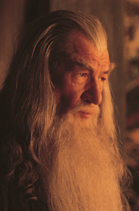 The change from Sir Ian to Gandalf requires the work of many make-up artists and costumers. Gandalf's appearance required an aged look, a long white beard and bushy eyebrows and the appropriate wizarding ensemble (which he established long before anyone had even heard of Harry Potter). Into the chair goes Sir Ian McKellan, and out comes Gandalf the Wizard. The change from Sir Ian to Gandalf requires the work of many make-up artists and costumers. Gandalf's appearance required an aged look, a long white beard and bushy eyebrows and the appropriate wizarding ensemble (which he established long before anyone had even heard of Harry Potter). Into the chair goes Sir Ian McKellan, and out comes Gandalf the Wizard.
The next step is to let the people of Gentle Giant Studios get their equipment set-up to take a three-dimensional picture of Sir Ian as Gandalf. After the equipment has been transported from the United States to New Zealand (and any damage repaired), the technicians set-up the laser scanners. The digital scanners are verified to be working properly, and the next victim, er, subject is brought in.
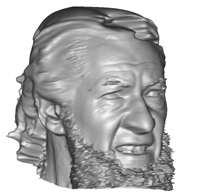 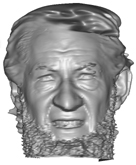 The actor sits in the scanning apparatus as a laser passes around their head. The laser works with computers to develop a three-dimensional 'map' of the actors head, with varying elevations to make up the features that make us all unique. While Gentle Giant can produce complete scans or a person's entire body, the scans for LOTR were only of the actors' likenesses, and not full body scans. This information is kept in the computers and is used by modeling programs to reconstruct the image. This reconstruction can be done digitally on the computer, to render an image that can be rotated and scaled, or it can be sent along to the next phase of the process - producing a hard copy. (Click on these two pictures for larger versions.) The actor sits in the scanning apparatus as a laser passes around their head. The laser works with computers to develop a three-dimensional 'map' of the actors head, with varying elevations to make up the features that make us all unique. While Gentle Giant can produce complete scans or a person's entire body, the scans for LOTR were only of the actors' likenesses, and not full body scans. This information is kept in the computers and is used by modeling programs to reconstruct the image. This reconstruction can be done digitally on the computer, to render an image that can be rotated and scaled, or it can be sent along to the next phase of the process - producing a hard copy. (Click on these two pictures for larger versions.)
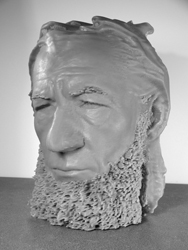
Gandalf in Wax
(Click for larger version)
Producing an actual physical representation from the computer data is called stereo-lithography, and that is what comes after a successful scan. This can also be done to the digital image data for a CG character. The first copy is produced in wax and can be sized by the prototyping machine to whatever scale is needed. After producing a highly detailed copy of the scanned actor you'd think the process would be complete, but that's just the beginning. After the computer has taken its shot, it's time to add the human touch.
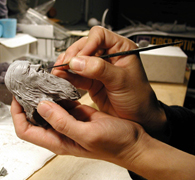 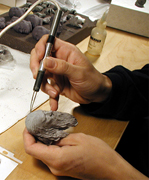 Ever notice that when a computer voice 'reads' something it sounds hollow, or that it seems to be missing something? Computers can make very accurate copies, but they just aren't able to add that spark that brings things to life, and this is where the sculptors come into the picture. Far from being a replacement for sculptors, the scans are just a tool to give the artists a base upon which to work. The sculptors at Gentle Giant then make changes to the hard copies to make the likeness better with the perspective of the Mark 1 Human Eyeball (still a classic). Ever notice that when a computer voice 'reads' something it sounds hollow, or that it seems to be missing something? Computers can make very accurate copies, but they just aren't able to add that spark that brings things to life, and this is where the sculptors come into the picture. Far from being a replacement for sculptors, the scans are just a tool to give the artists a base upon which to work. The sculptors at Gentle Giant then make changes to the hard copies to make the likeness better with the perspective of the Mark 1 Human Eyeball (still a classic).
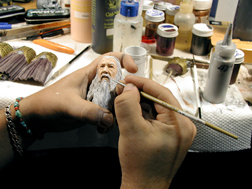
One thing the computer scanning does not capture is color. Since Ted Turner seems to have cornered the market on digital colorizing, Gentle Giant relies on in-house painters to get the job done. Painters can get the skin tones perfect, add some shading and establish just the right look for hair or eyes. After the paint has been applied the finished prototype is sent on for approval.
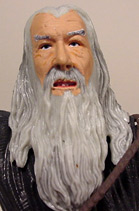 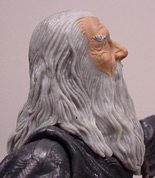 The approval process has traditionally had some difficulties. These difficulties were one of the reasons that Gentle Giant was created - to help produce better likenesses and streamline the approval process using computer scanning to aid the sculptors. Depending on contractual provisions, the sculpt may need to be approved by the actor, toy company and the studio. Once approved it can be used in the manufacturing process to produce the production pieces. The approval process has traditionally had some difficulties. These difficulties were one of the reasons that Gentle Giant was created - to help produce better likenesses and streamline the approval process using computer scanning to aid the sculptors. Depending on contractual provisions, the sculpt may need to be approved by the actor, toy company and the studio. Once approved it can be used in the manufacturing process to produce the production pieces.
From here, Toy Biz takes over and manufactures the action figures and gets them to a store near you, ready for action!
Photo of Sir Ian McKellan is by Keith Stern and is courtesy of McKellan.com. Used with permission.
|









